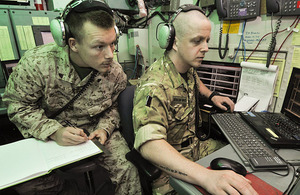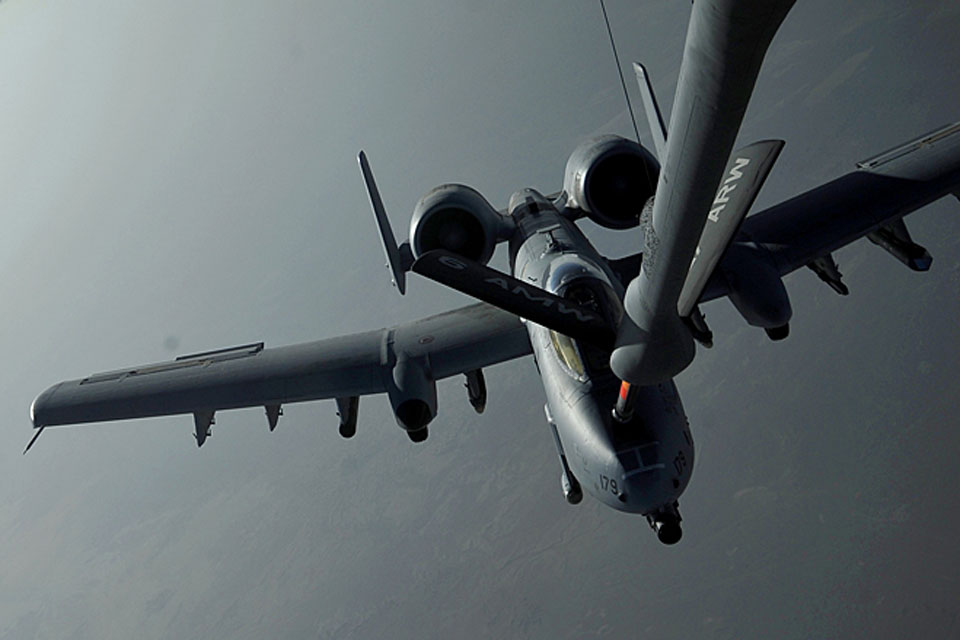RAF and USMC co-ordinate air campaign over Afghanistan
In the south and south west of Afghanistan, a team from the RAF is working with the US Marine Corps (USMC) on the daunting task of co-ordinating the use of some of the world's busiest airspace.

Aerospace Battle Managers Corporal Bobby Howard, US Marine Corps, and Corporal Paddy Bonner, Royal Air Force, working together at Camp Leatherneck, Helmand province, southern Afghanistan [Picture: Sergeant Ross Tilly RAF, Crown Copyright/MOD 2011]
Members of the RAF’s Aerospace Battle Management Team and the USMC Air Wing are colocated in a dusty, quiet and benign corner of sprawling Camp Leatherneck, a home from home for the US Marines serving in Helmand province.
The detachment is parented by the RAF’s 903 Expeditionary Air Wing, only a short drive into adjoining Camp Bastion; however, all of the UK’s Air Surveillance and Control System (ASACS) personnel live, work and socialise with their US Marine colleagues at Leatherneck, further enhancing their operational experience.
This close transatlantic partnership is responsible for controlling air power in one of Afghanistan’s most volatile areas. The airspace above Helmand and Kandahar provinces is a complex mix. As well as the many military remotely piloted air systems, fast jets, support helicopters, air-to-air tankers and transports, there are civilian aircraft to contend with, and there may even be missiles or artillery shells in the air that have to be added to the constantly changing three-dimensional picture.
Squadron Leader John Kane, the UK’s ASACS Detachment Commander, said:
The pressure on these guys is immense. All of the operators are acutely aware of the impact that their individual and collective actions have in support of the troops on the ground - mistakes cost lives.
Meanwhile at neighbouring Kandahar Airfield, reputed to be the busiest single-runway airfield in the world, two RAF Tornado GR4s thunder down the tarmac, and another mission in support of coalition troops gets underway. The jets soar into the Afghan sky and turn west towards Helmand, heading out for that day’s task; they don’t know it yet, but they will soon be working with US Marines on the ground.

A US Marine Corps A-10 Thunderbolt II 'Warthog' aircraft takes on fuel from a KC-135 Stratotanker aircraft over Afghanistan [Picture: Staff Sergeant Angelita Lawrence, US Air Force/ISAF 2009]
After clearing Kandahar’s busy air traffic control, they contact the US Marine Corps mobile command and control unit at Camp Leatherneck, responsible for providing the air defence of the southern region of Afghanistan. Yet the voice that answers isn’t that of a US Marine, but the distinctive tones of the Liverpudlian accent of one of the RAF’s embedded Aerospace Battle Managers (ABMs).
The British voice on the radio belongs to one of a number of personnel drawn from the UK’s ABM community - a joint Service group, including a Royal Navy exchange officer, who are charged with providing control, surveillance and battle management support to the US 2nd Marine Expeditionary Force.
As the pair of Tornado GR4s enter some of the busiest airspace in the world, they snap out their airspace request, aware of the volume of radio traffic, so keeping it short and to-the-point. To the untrained ear, their broadcast is an unintelligible stream of numbers and letters describing how Afghan airspace is divided.
Sitting in the tight confines of the control cabin with three other personnel, the controller’s eyes flick between her handwritten stack sheet and the radar screen. It is a surprisingly chilly space considering the outside temperature is 42 degrees Celsius; the almost refrigerator-like temperatures are essential in preventing the equipment from overheating, often forcing the controllers to don official US Marine Corps hoodies, not a normal sartorial choice during an Afghan summer, but a sensible option to keep comfortable whilst on station for long hours. She quickly changes the British jets’ flight level to deconflict with French aircraft already working in the same area, and clears them a safe transit route through the complex clutter of the Helmand skies.
Meanwhile, an RAF Surveillance Operator spots an air-to-air tanker entering the airspace. After identifying its track - the block of letters, numbers, colours and dots that show up on his screen – he calls it out to the controller.
The controller radios the tanker, rattling off the updates to the day’s ‘trade’ before vectoring two US Air Force A-10 ‘Warthog’ ground attack aircraft toward it for its first refuelling contact of the day.
Flight Lieutenant Glen Parker, the detachment Senior Traffic Director, said:
During a routine 12-hour shift we have to deal with a high-intensity workload managing hundreds of air and ground requests.
Whether it’s a change to the refuelling plan, identifying an unknown aircraft, dynamically co-ordinating aircraft to deconflict with artillery or rocket fire, supporting a range of operations, or simply getting the right asset in the right place at the right time, our operators ensure all requests are met as efficiently, expeditiously and safely as possible.
Abruptly the Surveillance Director’s voice crackles over the internal communications network: “Troops-in-Contact”. All ears tune in as the Tornados are retasked to support a US Marine Corps infantry unit that has been attacked by insurgents. The controller directs them to the quickest possible route to support, clearing other aircraft away from their path and checking their estimated time to the contact. As they approach their tasking, they ask to descend to low level and push on towards the fire fight.
By the time they switch to the US Marine Corps Direct Air Support Centre (DASC) - the direct link between air and ground forces - the plan will be set. Without radar, it is impossible for the controllers to give vectors or offer bearings to the other traffic jostling for airspace in close proximity, so instead they use a procedural service to keep the aircraft away from each other and deconflicted from artillery and rocket fire.
They use a specific set of instructions, which include where it is safe to climb or descend, what is working in and around the jets, and any updated information on their new mission. Again, they may be surprised to catch the Scottish Highland tones of the Tactical Air Director, part of a similarly small group of ABMs augmenting the current Marine Air Support Squadron based in Helmand.
With ground units ready to engage and close air support poised overhead, a shout from a Joint Terminal Attack Controller for a ‘show of force’ ramps up the tension.
The process of getting the two Tornados close to the surface begins; the pilots will be accelerating while descending to 100ft (31m) above the terrain, a manoeuvre that generates shock and awe intended to scare and discourage the insurgents from continuing their attack.
Co-ordination is vital with the Helicopter Director to ensure that the airspace is clear of helicopters and tactical remotely piloted air systems which are supporting the fight in a nearby area.
A request soon follows for a MEDEVAC - the evacuation of injured people - from the same location. More instructions are passed to the jets, indicating the single safe route to descend and climb, before switching to the Joint Terminal Attack Controller on the ground. The MEDEVAC helicopter lifts off, its injured passengers already receiving critical care on board, and is cleared direct to the hospital at Camp Bastion as a priority. The atmosphere is tense and the chatter continues to increase with the pushing of information to those who need to know. As the jets climb and the helicopters depart, the sombre realities of this campaign settle in, but not for long… as it’s all about to start again.
Flight Lieutenant Lynn, a Tactical Air and Helicopter Director, said:
The challenge of deconflicting extremely tight and congested airspace, without the use of radar, is exhilarating. Just when you think you have a solid plan, a Troops-in-Contact or Medical Emergency Response Team [MERT] mission crops up and you have to dynamically rework it to ensure continuous support to the guys on the ground. The Trade Group 12 operators play a significant role in managing the remotely piloted air system assets and highlighting any flaws in the Director’s plan, ensuring a safe and permissive operating environment.
Although they are two separate entities, the link between the teams at Leatherneck and DASC is seamless, with the operators utilising a number of different systems to communicate securely and transfer assets between their areas of responsibility. In the event that either unit loses its communications systems the other acts as an immediate back up, albeit in a limited capacity.
Meanwhile, back at Leatherneck, a request comes in for a shot from the Multiple Launch Rocket System, based nearby, to be fired deep into the Green Zone of the Helmand Valley.
The surveillance team plots the airspace the rockets will fly through; plotting them incorrectly could be disastrous, so care and speed must be balanced.
As soon as the area pops up on the system, the remotely piloted air systems and the fixed-wing controller go to work; clearing all assets out of the affected sky, the traffic director waits to see a thumbs-up from them both before letting everyone know that the skies are clear.
The sight and sound of the rockets firing reminds everyone of the critical task they’re undertaking, but there is no time to dwell - the next task is already brewing.
The high-pressure and intense working environment forms a tight-knit community and the camaraderie between the two Services is excellent, engendering a ‘one team - one fight’ ethos.
The USMC Tactical Control Detachment Commander, Major Mark Micke, said:
The RAF ASACS personnel make an excellent contribution to operations on a daily basis and provide vital continuity during the biannual US Marine Corps personnel replacement periods.
Squadron Leader Kane added:
I am extremely proud to command the men and women deployed here from the RAF Aerospace Battle Management community.